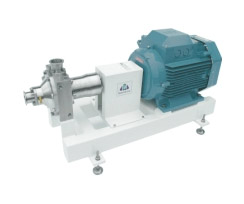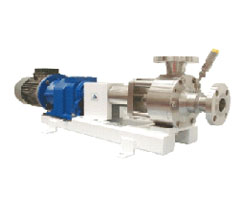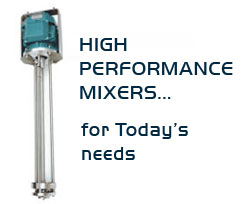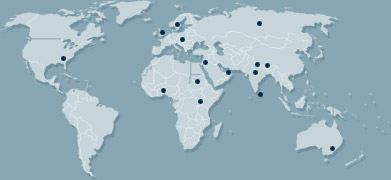Licensee Of
Maelstrom High
Shear Mixers - U.K
Top-Notch Technology In Production Of Oils And Fats
If you are new to the subject of fluid mixing and are looking for some help on terminology and an answer to the question, "why are there so many kinds of fluid mixers?", then we hope that you will find this page helpful. There are some suggestions on further reading at the bottom of the page.
A fluid system in this context means a combination of materials which combine to form a fluid, where a fluid is defined as matter which cannot sustain a shear force while at rest. In particular, we are considering liquid-liquid and solid-liquid mixing systems here, as distinct from dry powder or gas-liquid mixing systems.
Most fluid mixing problems can be considered in terms of the miscibility (the ease of mixing) of the system components. Miscibility can in turn be thought of as the ease of distribution and the ease of particle size reduction - this affects the mixing approach to be adopted. For instance, where the rate of reaction between miscible components is to be improved, mixing efforts are focused on maximising distribution, while for mixing immiscible fluids, efforts are focused on reducing droplet or particle size to maximise the area of contact between the phases.
A further consideration is the type of production process involved, of which the fluid mixing is normally only a part. The most important distinction that affects the mixing operation is whether the process is batch or continuous in nature. In a batch process, a discrete volume of material is mixed, usually within a vessel; in a continuous process, a stream of material is mixed, usually piped to and from the mixer.
In an ideal world, it would be possible to choose the appropriate mixing action to suit the requirements of the fluid and then select either a batch or continuous form. In practice, many mixing technologies are offered in either batch or continuous form but not both. In situations where both are offered, there are normally some performance trade-offs. Many fluid production processes are actually defined around the kind of mixer that is used, often for reasons of expediency or "standard practice". This makes it difficult for those working to innovate new fluid products to make use of new production processes and methods.
Mixers offered by Maelstrom are mostly available in both batch and continuous forms and care has been taken to minimise performance trade-offs to make selection easier and more secure.
For distributive action, swirl created by rotating parts causes laminar thinning of the material interfaces, thereby increasing volumetric combination of the materials. A repeated cutting and folding action of the mixture also increases the distribution of different material components. The effectiveness and efficiency of a mixer in distributive mixing is therefore a function of how the machine interacts with the fluid in a geometric sense.

Conversely, the effectiveness and efficiency of a mixer in dispersive mixing is a function of how the machine interacts with the fluid in a stressing sense. For most materials, the higher the stress, the smaller the resulting particles or droplets in the mixture. However, another very important consideration is the uniformity of the stress field. Without a reasonable uniformity, it is impossible to guarantee that the same stress is applied to all parts of the fluid. This would result in a wide range of final droplet or particle sizes rather than a narrow range obtained with uniform stressing.
One or more of the three primary stressing mechanisms are used in most fluid mixers. These mechanisms are:
Of these mechanisms, the most effective is extensional stressing. This is why nozzle valve homogenisers are used to create many of the ultra-fine dispersions demanded by process industries, despite their many practical disadvantages, and is why the common "high-shear" mixers are relatively ineffective and inefficient for dispersive mixing.
Mixer Types
Although there are as many types of mixers as there are terms for describing them, for fluid mixing they essentially break down into the following:
Impellers - normally comprising specially shaped blades on a rotating shaft, driven by some form of motor or geared drive - batch use almost entirely, but more than 55% of the mixing equipment market is made up of these devices, which come in a bewildering array of sizes and shapes.
Special agitators/blenders - this covers a range of special purpose machines which are normally for batch use only and are designed for a particular duty. Although there are often many disadvantages in using these devices such as cleanability, inefficiency and so on, their use is sometimes vital in creating certain mixing effects. The group includes ribbon mixers, pin mixers, anchors, z-blades and dozens more.
The Maelstrom Fluid Division Mixer falls into this category when operating at low speed as it is capable of very high distributive performance through its dynamic use of structured cutting and folding whilst imparting almost no shear stress into the product. This is very beneficial where shear-sensitive products need to be blended in either continuous or batch mode.
Static mixers - a relatively recent development (in the 1960s), these are devices for continuous use only which comprise a set of non-moving obstructions in a pipeline. The obstructions are shaped and positioned in such as way as to create cutting and folding effects and/or turbulence for mixing of piped fluid streams. Although cleanability is an issue, static mixers are a reliable and low cost alternative in a wide range of inline blending applications. It should be noted however, that any high pressure drop across the mixer must be compensated for by larger and more expensive pumps.
Mills - available in various forms for both batch and continuous use, mills generally use compressive and/or shear stresses to create dispersions by crushing or grinding the fluid material between moving surfaces. A two-roll mill, as the name suggests, comprises two rotating cylinders which rotate to crush and grind material between them. The other common type, the bead mill, uses hardened metal beads inside a tumbling cylinder through which the fluid is passed to give a random crushing of the fluid. Due to the way they work, mills are particularly suited to particle size reduction of solids which are suspended in fluids, although throughputs rates are generally quite low.
The Maelstrom High Stress Mixer operates with a milling action although its milling faces are specially profiled to provide additional extensional stress and distributive mixing in visco-elastic materials.
Rotor-stator dispersers - usually called "high-shear mixers", are the most common form of dispersing mixer. By placing a form of closely-fitting shroud around a high speed impeller, it is possible to create a shearing action between the blades and stator shroud. As material is centrifugally pumped through the mixing head, some of it will see this high shear zone and experience shear stressing that results in dispersive mixing. Where small or uniform dispersions are required, material must be cycled through the head many times to ensure statistically that all of the material has passed through the high shear zone at least once. The viscosity range handles is also restricted due to the centrifugal pumping action. Although performance is therefore limited, rotor-stator machines are fairly flexible in their duties and are available in both batch and continuous forms.
The Maelstrom Fluid Division Mixer falls into this category when operating at high speed in turbulent mode as it combines an intense hydraulic shear with its excellent blending capability. The uniformity of the high shear field in the mixing head means that some of the problems associated with stress uniformity in normal high shear mixers are avoided. FDM machines typically put 5 times more energy into fluid than equivalent high shear mixers.
Special purpose dispersers - a range of complex machines and systems which deliver very good uniform dispersions, normally in particular fluid applications. For example, high pressure valve homogenisers are used in the processing of milk to ensure that the milk fats droplets are reduced in size and evenly dispersed throughout the bulk. This stops the cream separating from the milk. The valve homogeniser comprises a very high pressure pump and a controlled valve nozzle through which the fluid is forced at very high velocity to rupture the fat droplets through extensional stressing. The jet impinging mixer is another type of disperser which uses high velocity fluid streams, except that in this case, the fluid is jetted against a plate or contra-jet to rupture the droplets or particles using impact stressing. Ultrasonic mixers and membrane mixers provide extremely small droplet sizes, although their cost, complexity and fragility mean that few are used in medium to large volume production applications.
Integral Pump Mixers - can really be treated as a separate class of mixing device due to the way that they combine a number of different stressing and distribution mechanisms to achieve both high dispersion and high distribution performance. Available in both batch and continuous forms, Integral Pump Mixers use internally generated positive displacement pumping to force fluid through small nozzles at very high energies whilst extending and shearing it. The fluid flowing through the nozzles at high velocity then impinges on an internal wall of the mixer. A dynamic cutting and folding action added to vigorous turbulent flow provides distributive mixing. Integral Pump Mixers are suited to a wide variety of applications due to their ability to handle a wide range of materials and viscosities, their high performance and their economic benefits.
Find out more about Integral Pump Mixing technology and products available from Maelstrom Advanced Process Technologies.

Dispersive Action
Reduces particle and droplet sizes in a mixture. Primarily a function of mixing energy input.
See the Mixing Primer for a more detailed description.
An Introduction to High Performance Fluid Mixing
There are a vast number of technologies, machines and devices to perform fluid mixing tasks, although none can be used for all mixing duties. Not surprisingly, this makes the selection of mixers both complex and confusing for most mixer users and is one of the main reasons why fluid mixing is still the subject of intense academic research even after thousands of years of development!If you are new to the subject of fluid mixing and are looking for some help on terminology and an answer to the question, "why are there so many kinds of fluid mixers?", then we hope that you will find this page helpful. There are some suggestions on further reading at the bottom of the page.

What is Fluid Mixing?
The "mixing" of one or more components or materials in a "fluid system" can be described in terms of two separate but interlinked physical processes:- Blending ("distribution") of different components of the mixture to create uniformity throughout the mix, and
- Droplet or particle size reduction ("dispersion") of one or more components of the mixture to give increased homogeneity of the system or to alter the nature of the system by increasing the contact surface area between the components, i.e. reducing the particle or droplet sizes increases their contact surface area to volume ratio.
A fluid system in this context means a combination of materials which combine to form a fluid, where a fluid is defined as matter which cannot sustain a shear force while at rest. In particular, we are considering liquid-liquid and solid-liquid mixing systems here, as distinct from dry powder or gas-liquid mixing systems.
Most fluid mixing problems can be considered in terms of the miscibility (the ease of mixing) of the system components. Miscibility can in turn be thought of as the ease of distribution and the ease of particle size reduction - this affects the mixing approach to be adopted. For instance, where the rate of reaction between miscible components is to be improved, mixing efforts are focused on maximising distribution, while for mixing immiscible fluids, efforts are focused on reducing droplet or particle size to maximise the area of contact between the phases.
A further consideration is the type of production process involved, of which the fluid mixing is normally only a part. The most important distinction that affects the mixing operation is whether the process is batch or continuous in nature. In a batch process, a discrete volume of material is mixed, usually within a vessel; in a continuous process, a stream of material is mixed, usually piped to and from the mixer.
In an ideal world, it would be possible to choose the appropriate mixing action to suit the requirements of the fluid and then select either a batch or continuous form. In practice, many mixing technologies are offered in either batch or continuous form but not both. In situations where both are offered, there are normally some performance trade-offs. Many fluid production processes are actually defined around the kind of mixer that is used, often for reasons of expediency or "standard practice". This makes it difficult for those working to innovate new fluid products to make use of new production processes and methods.
Mixers offered by Maelstrom are mostly available in both batch and continuous forms and care has been taken to minimise performance trade-offs to make selection easier and more secure.

Fluid Mixing Mechanisms
In terms of mechanical mixing mechanisms, a number of actions are employed by different types of mixers to create different effects for particular process results.For distributive action, swirl created by rotating parts causes laminar thinning of the material interfaces, thereby increasing volumetric combination of the materials. A repeated cutting and folding action of the mixture also increases the distribution of different material components. The effectiveness and efficiency of a mixer in distributive mixing is therefore a function of how the machine interacts with the fluid in a geometric sense.

Conversely, the effectiveness and efficiency of a mixer in dispersive mixing is a function of how the machine interacts with the fluid in a stressing sense. For most materials, the higher the stress, the smaller the resulting particles or droplets in the mixture. However, another very important consideration is the uniformity of the stress field. Without a reasonable uniformity, it is impossible to guarantee that the same stress is applied to all parts of the fluid. This would result in a wide range of final droplet or particle sizes rather than a narrow range obtained with uniform stressing.
One or more of the three primary stressing mechanisms are used in most fluid mixers. These mechanisms are:
| SHEAR |  |
| EXTENSION |  |
| IMPACT |  |
Of these mechanisms, the most effective is extensional stressing. This is why nozzle valve homogenisers are used to create many of the ultra-fine dispersions demanded by process industries, despite their many practical disadvantages, and is why the common "high-shear" mixers are relatively ineffective and inefficient for dispersive mixing.
Mixer Types
Although there are as many types of mixers as there are terms for describing them, for fluid mixing they essentially break down into the following:
Impellers - normally comprising specially shaped blades on a rotating shaft, driven by some form of motor or geared drive - batch use almost entirely, but more than 55% of the mixing equipment market is made up of these devices, which come in a bewildering array of sizes and shapes.
Special agitators/blenders - this covers a range of special purpose machines which are normally for batch use only and are designed for a particular duty. Although there are often many disadvantages in using these devices such as cleanability, inefficiency and so on, their use is sometimes vital in creating certain mixing effects. The group includes ribbon mixers, pin mixers, anchors, z-blades and dozens more.
The Maelstrom Fluid Division Mixer falls into this category when operating at low speed as it is capable of very high distributive performance through its dynamic use of structured cutting and folding whilst imparting almost no shear stress into the product. This is very beneficial where shear-sensitive products need to be blended in either continuous or batch mode.
Static mixers - a relatively recent development (in the 1960s), these are devices for continuous use only which comprise a set of non-moving obstructions in a pipeline. The obstructions are shaped and positioned in such as way as to create cutting and folding effects and/or turbulence for mixing of piped fluid streams. Although cleanability is an issue, static mixers are a reliable and low cost alternative in a wide range of inline blending applications. It should be noted however, that any high pressure drop across the mixer must be compensated for by larger and more expensive pumps.
Mills - available in various forms for both batch and continuous use, mills generally use compressive and/or shear stresses to create dispersions by crushing or grinding the fluid material between moving surfaces. A two-roll mill, as the name suggests, comprises two rotating cylinders which rotate to crush and grind material between them. The other common type, the bead mill, uses hardened metal beads inside a tumbling cylinder through which the fluid is passed to give a random crushing of the fluid. Due to the way they work, mills are particularly suited to particle size reduction of solids which are suspended in fluids, although throughputs rates are generally quite low.
The Maelstrom High Stress Mixer operates with a milling action although its milling faces are specially profiled to provide additional extensional stress and distributive mixing in visco-elastic materials.
Rotor-stator dispersers - usually called "high-shear mixers", are the most common form of dispersing mixer. By placing a form of closely-fitting shroud around a high speed impeller, it is possible to create a shearing action between the blades and stator shroud. As material is centrifugally pumped through the mixing head, some of it will see this high shear zone and experience shear stressing that results in dispersive mixing. Where small or uniform dispersions are required, material must be cycled through the head many times to ensure statistically that all of the material has passed through the high shear zone at least once. The viscosity range handles is also restricted due to the centrifugal pumping action. Although performance is therefore limited, rotor-stator machines are fairly flexible in their duties and are available in both batch and continuous forms.
The Maelstrom Fluid Division Mixer falls into this category when operating at high speed in turbulent mode as it combines an intense hydraulic shear with its excellent blending capability. The uniformity of the high shear field in the mixing head means that some of the problems associated with stress uniformity in normal high shear mixers are avoided. FDM machines typically put 5 times more energy into fluid than equivalent high shear mixers.
Special purpose dispersers - a range of complex machines and systems which deliver very good uniform dispersions, normally in particular fluid applications. For example, high pressure valve homogenisers are used in the processing of milk to ensure that the milk fats droplets are reduced in size and evenly dispersed throughout the bulk. This stops the cream separating from the milk. The valve homogeniser comprises a very high pressure pump and a controlled valve nozzle through which the fluid is forced at very high velocity to rupture the fat droplets through extensional stressing. The jet impinging mixer is another type of disperser which uses high velocity fluid streams, except that in this case, the fluid is jetted against a plate or contra-jet to rupture the droplets or particles using impact stressing. Ultrasonic mixers and membrane mixers provide extremely small droplet sizes, although their cost, complexity and fragility mean that few are used in medium to large volume production applications.
Integral Pump Mixers - can really be treated as a separate class of mixing device due to the way that they combine a number of different stressing and distribution mechanisms to achieve both high dispersion and high distribution performance. Available in both batch and continuous forms, Integral Pump Mixers use internally generated positive displacement pumping to force fluid through small nozzles at very high energies whilst extending and shearing it. The fluid flowing through the nozzles at high velocity then impinges on an internal wall of the mixer. A dynamic cutting and folding action added to vigorous turbulent flow provides distributive mixing. Integral Pump Mixers are suited to a wide variety of applications due to their ability to handle a wide range of materials and viscosities, their high performance and their economic benefits.
Find out more about Integral Pump Mixing technology and products available from Maelstrom Advanced Process Technologies.

Mixing Technology Overview

Dispersive Action
Reduces particle and droplet sizes in a mixture. Primarily a function of mixing energy input.
See the Mixing Primer for a more detailed description.
| Integral Pump Mixing (IPM) |
A highly tuneable and scalable technology patented by Maelstrom APT and suited to a very wide fluid viscosity range. With its integrated positive displacement pumping and nozzle homogenisation actions, IPM offers very high energy transfer for exceptional dispersive performance. IPM is available in batch and continuous forms. | |
| Fluid Division Mixing (FDM) |
Depending on its configuration, FDM can be used in both high shear and ultra-low shear applications. Using the principle of hydraulic shear for high shear applications, FDM machines offer improved performance over conventional high shear mixers in both batch and inline forms. In low-shear mode, FDM uses an inter-cavity transfer mechanism to provide an effective but gentle blending action for shear-sensitive materials. | |
| High Stress Mixing (HSM) |
Intended for visco-elastic materials such as rubber and other polymers, doughs and pastes, HSM delivers energy-intensive shear and extensional stresses for rapid compounding and blending. Large surface contact area and integrated cooling channels enable fast mixing of temperature-sensitive compounds. | |
| Controllable Deformation Dynamic Mixing (CDDM) | For the ultimate in dispersive and distributive performance, CDDM combines multi-nozzle homogenisation with inter-cavity transfer principles to create an exceptionally high performance inline mixer. Licensed from one of the world's leading process companies, this technology is ideally suited to emulsification, reaction chemistry and dilution applications. |
















